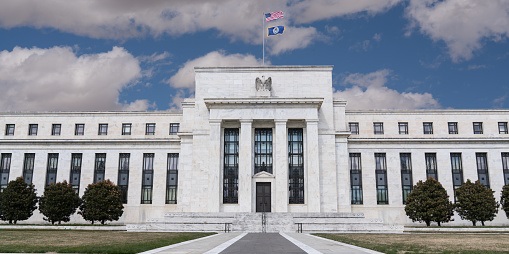As has been the case since the start of the week, major US equity indices continue to trade within thin ranges and close to record levels. Index futures are pointing to a fairly flat open, with E-mini-S&P 500 futures trading in the upper half of this week’s 4160-4190ish range (around 4180). The index does not seem to be much moved in wake of earnings results from Amazon (down 2% in pre-market trade) and Google (up 5% in pre-market trade), both released after the close last night.
E-mini-Nasdaq 100 futures are trading just above the 13900 mark, having found some support at yesterday’s lows after seeing a modest drop as a result of a pick in US government bond yields during yesterday’s session (Big Tech has a negative correlation to long-term interest rates). The move higher in yields seems to have carried forward into today’s session and, at present, the US 10-year bond yield is just above 1.64%, up about 2bps on the day and 9bps since the start of the week. Price action is unlikely to get too wild ahead of today’s key events, however; 1) the FOMC set monetary policy at 1900BST and then Fed Chair Jerome Powell will partake in his usual post rate decision press conference 30 minutes later which will include a Q&A with the press and 2) US President Biden will deliver an address to Congress on his American “Families Plan” proposal.
The aforementioned pick up in US government bond yields and subsequent steeping of the treasury curve (the 2s/10s spread is back above 146bps) is lending USD a helping hand, with the Dollar Index (DXY) for now holding to the north of the 91.00 mark, though trade is likely to remain subdued ahead of key events. Indeed, the buck currently sits in third place in the G10 rankings, behind NZD and NOK, the latter of whom seems to be deriving some impetus from modest strength in crude oil prices (oil has shrugged off OPEC’s decision to press ahead with output hikes in the coming months and seems to like positive pandemic news out of the EU) and the former of whom seems to be deriving some support from weakness in the AUD/NZD cross that has seen its drop to fresh monthly lows under the 1.0750 level (which happens to also coincide with the pair’s 200DMA).
AUD/NZD weakness is more as a result of weakness in AUD than in the kiwi; key Q1 CPI data was released by the Australian Bureau of Statistics last night and inflation was much cooler than expected, with the QoQ rate of headline inflation coming in at 0.6% (expectations were for 0.9%) while the YoY rate of headline inflation came in at 1.1% (expectations were for 1.4%). The Reserve Bank of Australia’s Trimmed Mean CPI readings were also soft, coming in at 0.3% (versus 0.5% expected) QoQ and 1.1% (versus 1.2% expected) YoY. Soft inflation strengthens the narrative that the RBA is likely to be on hold for quite some time yet and has hence weighed on the Aussie, though a pullback in copper prices (a key Australian export) has also not helped – the threat of strikes at Chilean ports (Chile produces one quarter of global copper) have been avoided after the Chilean President caved into demands not to veto an opposition sponsored bill that allows Chileans to withdraw money from their pension savings. Note that many desks still remain bullish on copper and other commodities, with Goldman Sachs recently predicting that LME copper will hit $11K per tonne; traders are citing increased demand for the metal in the EV space.
Returning to FX markets; though the Aussie sits close to the bottom of the G10 pile, it is JPY and GBP that are fairing the worse, both lower on the day by about 0.3% versus the buck. The yen may be softer as a result of an improved appetite for risk in Japan overnight following the release of stronger than expected Japanese Retail Sales numbers for the month of March), or it could be as a result of the currencies sensitivity to increases in US government bond yields. Either way, USDJPY is currently probing the 109.00 level, up from around 108.20 just 24 hours ago. GBP, meanwhile, may be suffering as a result of continued press drama around the various scandals currently plaguing PM Boris Johnson – in the latest news, the UK Electoral Commission said that it would investigate the refurbishment of Johnson’s Downing Street flat given that “there are reasonable grounds to suspect that an offence or offences may have occurred”. Typically, UK PM Boris Johnson has been a GBP positive and anything that threatens his position as PM (and the conservatives in government) might be seen as sterling negative.
Finishing off with the rest of the G10 currencies; CAD is flat on the session with USDCAD recently crossing under 1.2400 again ahead of the release of Canadian retail sales data for the month of February at 1330BST. EUR is a tad softer though EURUSD has remained supported to the north of the 1.2050 mark; data this morning was not great, with the GfK German Consumer Climate survey for the month of May disappointing a little, though pandemic news has been good with French PM Castex recently stating that the Covid-19 situation in the country is improving, the virus’ R rate is at 0.89 and French President Macron will present progressive exit from lockdown on Friday. CHF is also a tad softer despite an improvement in this morning’s Swiss April ZEW Expectations survey.
The Day Ahead
As noted, the FOMC monetary policy meeting (1900BST then 1930BST press conference) and US President Biden’s address to Congress (0200BST on Thursday) are the main events to watch. With regards to the former, no new economic forecasts will be released, so traders will eye the bank’s updated statement for evidence as to whether the Committee’s view on the US economy has improved or not (given strong recent data, more positive language is likely). Despite optimism about the outlook, the Fed is expected to maintain its dovish guidance (no tapering of QE until substantial progress made towards inflation and employment goals and no interest rate rises until inflation sustainably above 2.0% and full employment); Fed Chair Powell is likely to hammer home the point that the economy remains a long way from the Fed’s goals and until all of that slack is absorbed, there will be no rate hikes. Markets will also look for any hints as to what economic criteria might enable the Fed to start tapering asset purchases.
In terms of other key events to watch, we have US Wholesale Inventories for the month of March and Canadian Retail Sales for the month of February at 1330BST, ECB President Christine Lagarde will be speaking at 1500BST and the US EIA releases its weekly crude oil inventory report at 1530BST. Kiwi traders will be watching out for the release of trade numbers at 2345BST.




